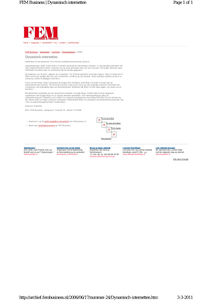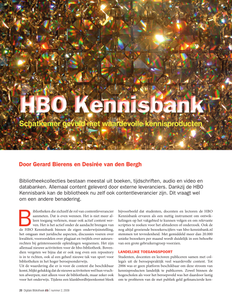In dit artikel wordt ingegaan op de snel veranderende digitale wereld. Want het stof rondom de term 'web 2.0' mag zo langzamerhand dan wel opgetrokken zijn, vragen blijven er genoeg. Welke impact hebben al die elkaar steeds sneller opvolgende ontwikkelingen nu eigenlijk op bibliotheken? In hoeverre dringt web 2.0 al door in de organisatie, in de werkprocessen, de klantbenadering en in de digitale bibliotheek? Vergt het wellicht ook een andere attitude van de bibliotheekmanager? En welke gevolgen heeft web 2.0 voor het functieprofiel van de informatiespecialist? Vragen als deze en nog meer, worden in dit artikel verder uitgediept.
DOCUMENT

In dit stuk gaan we zien wat Web 2.0 is, de invloed ervan op projectmanagement en meer specifiek op de wijze waarop ICT-projecten volgens de principes van Web 2.0 zouden kunnen worden uitgevoerd. Daarbij kijken we uiteraard ook naar de veranderende rollen van degenen die vaak betrokken worden in dergelijke projecten; natuurlijk de projectmanager zelf, maar ook ontwikkelaars en, typisch Web 2.0, de gebruiker. Tenslotte komen een aantal project management 2.0 applicaties aan bod, maar laten we beginnen met de elementaire zaken.
DOCUMENT
Listening to students’ voices might result in the design of more effective learning practices, assuming that learning and teaching can be attuned more adequately in those practices. Therefore, research was carried out to investigate the characteristics of successful innovative learning practices using Web 2.0 technologies to establish to what extent they might serve as a model for learning practices in more or less similar contexts. Five learning practices were investigated through a range of processes including document analysis and by interviewing students. Additionally, a cross case analysis was carried out to track down success factors of teaching and learning with Web 2.0 technologies, and to find out to what extent these practices are contextual. The analysis showed the importance of co-production and co-creation in learning practices supported by the use of Web 2.0 technologies, and the crucial role of students’ motivation and teacher’s willingness to experiment with new learning practices.
LINK
Over the past 15 years the Web has transformed the ways in which we search for information and use it. In more recent years, we have seen the emergence of a new array of innovative tools that collectively go under the name of 'Web 2.0', in which the information user is also increasingly an information producer (i.e., prosumer), by sharing or creating content. The success of Web 2.0 tools for personal use is only partially replicated in the professional sphere and, particularly, in the academic environment in relation with research and teaching. To date, very few studies have explored the level of adoption of Web 2.0 among academic researchers in their research and teaching activity. It is not known in what way how and how much Web 2.0 is currently used within research communities, and we are not aware of the drivers and the drawbacks of the use of Web 2.0 tools in academia, where the majority of people is focused either on research or on teaching activities. To analyse these issues, i.e. the combined adoption of Web 2.0 tools in teaching and research, the authors carried out a survey among teaching and researching staff of the University of Breda in The Netherlands. This country was chosen mainly because it is on the cutting edge as far as innovation is concerned. An important driver in choosing the Breda University's academic community was the fact that one of the two authors of this survey works as senior researcher at this university. The purpose of our survey was to explore the level of adoption of Web 2.0 tools among the academic communities. We were interested in investigating how they were using these tools in the creation of scientific knowledge both in their research and teaching activity. We were also interested in analysing differences in the level of adoption of Web 2.0 tools with regard to researchers' position, age, gender, and research field. Finally, in our study we explored the issue of peer reviewing in the Web 2.0 setting. In particular, we investigated whether social peer review is regarded by researchers as a viable alternative to the current closed peer review system (single-blind or double blind). We approached about 60 staff members, but only 12 faculty members completed the survey fully. This means that our results can only be regarded as exploratory, but we still believe that they represent a complementary perspective with respect to previous studies.
LINK
On the internet we see a continuously growing generation of web applications enabling anyone to create and publish online content in a simple way, to link content and to share it with others: wellknown instances include MySpace, Facebook, YouTube, Flickr, Wikipedia and Google Earth. The internet has become a social software platform sailing under the Web 2.0 flag, creating revolutionary changes along the way: the individual, the end-user, comes first and can benefit optimally from an environment which has the following keywords: radically user-oriented, decentralized, collective and massive. ‘An environment in which each participant not only listens, but can also make his own voice heard’: the Social Web. This document describes a brief exploration of this Social Web and intends to gain insight in possible fundamental changes this phenomenon is causing or might cause in our society. Particular attention will be paid to the impact of the Social Web on learning and education. For how do two apparently contrary developments touch and overlap? On the one side we have the rapid growth of technologies bringing individuals together to communicate, collaborate, have fun and acquire knowledge (social software). And on the other hand we have the just conviction within the world of education that young people should not only acquire knowledge and information, but should also have all kinds of skills and experience in order to meet social and technological changes deliberately, and prepare for a life long of learning.
DOCUMENT

Heeft Web 2.0 de toekomst? Of is het het zoveelste buzzword dat vooral in marketingkringen leeft? Onder Web 2.0 worden dynamische internetsites verstaan. In veel gevallen gebruiken die sites programmeertechnieken waarmee rap op maat gemaakte sites zijn op te bouwen. Die putten daarvoor weer informatie uit andere sites en combineren die tot nieuwe gegevens.
DOCUMENT

In diesem Vortrag möchte ich einen Blick auf die möglichen Synergien zwischen den neuen Medien und dem Theater werfen, doch vielleicht anders als dies üblicherweise getan wird. Statt den Gebrauch von Videoprojektoren auf der Bühne zu untersuchen oder Schauspieler und Tänzer mit Geräten zur Verfolgung von Bewegungsabläufen auszustatten, möchte ich vorschlagen, dass das Theater einige der kritischen Ideen integriert, die wir in den letzten Jahren in unseren Untersuchungen der sozialen Medien und des Web 2.0 entwickelt haben.
DOCUMENT

Deze publicatie steunt in grote mate op twee onderzoeksprojecten die de afgelopen anderhalf jaar zijn uitgevoerd. Het eerste onderzoeksproject betreft het onderzoek naar Web 2.0 als leermiddel dat in opdracht van Kennisnet is uitgevoerd door BMC en het lectoraat Crossmedia Content van de Faculteit Communicatie en Journalistiek Hogeschool Utrecht. De doelstelling van het onderzoek was inzicht te verkrijgen in het gebruik en de opbrengsten van informele leermiddelen en de toepassing van Web 2.0 voor leren door leerlingen voortgezet onderwijs en middelbaar beroepsonderwijs. Het onderzoek was een aanvulling op voorafgaand onderzoek naar informele leermiddelen en Web 2.0 in het onderwijs vanuit het perspectief van de docent en de onderwijsorganisatie (Onstenk, 2007). Een samenvatting van de belangrijkste resultaten van het onderzoek zijn gepubliceerd door Kennisnet (Kanters & Van Vliet, 2009). Voor dit cahier Wijs met Media is teruggegrepen op het onderliggende onderzoeksrapport en is aanvullend literatuuronderzoek gedaan. Het tweede onderzoeksproject dat ten grondslag ligt aan deze publicatie is het project Cultuurwijsheid. Dit project is uitgevoerd door een breed consortium van kennisinstellingen (Hogeschool Edith Stein, Hogeschool Utrecht), cultureel erfgoed instellingen en science centra (TwentseWelle, Universiteitsmuseum Utrecht, Naturalis, Museon en andere), onderzoeksinstellingen (Novay), intermediairs (BMC) en basisscholen, in het kader van de RAAK-Publiek subsidieregeling. Uitgangspunt voor dit project was de stelling dat cultureel erfgoed bij uitstek geschikt is als duiding van een complexe wereld door (historische) context te bieden aan (actuele) gebeurtenissen.
DOCUMENT

On the internet we enjoy a continuously growing generation of web applications enabling anyone to create and publish online content in a simple way, to link content and to share it with others. The internet has become a social software platform sailing under the Web 2.0 flag, creating revolutionary changes along the way: the individual, the end-user, comes first and can benefit optimally from an environment which has the following keywords: radically user-oriented, de-centralized, collective and massive. An environment in which each participant not only listens, but can also make his own voice heard: the Social Web.
DOCUMENT

Studenten, docenten en lectoren publiceren samen met collega's uit de beroepspraktijk veel waardevolle content. Tot 2006 was er geen platform beschikbaar om deze stroom van kennisproducten landelijk te publiceren. Zowel binnen de hogescholen als voor het beroepenveld was het daardoor lastig om te profiteren van de met publiek geld gefinancierde kennisproducten, laat staan dat er op kon worden voortgebouwd. Als reactie hierop werd op initiatief van het Samenwerkingsverband Hogeschool Bibliotheken en SURFfoundation de HBO-Kennisbank gelanceerd. In dit artikel gaan we in op de meerwaarde van HBO Kennisbank voor bibliotheek, onderwijs en het beroepenveld; ook wordt aandacht besteed aan de architectuur en de laatste ontwikkelingen rondom HBO Kennisbank.
DOCUMENT
